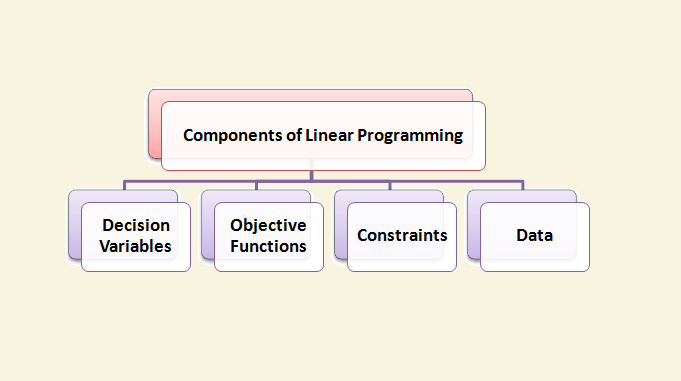
Components of Linear Programming:
The following are the elements, parts, or basic components of the linear programming model:
- Decision variables
- Objective function
- Constraints
- Non-negativity
- Data
1. Decision variables –
Decision variables are the quantities that are to be calculated. They are the variables in a mathematical programming model that are unknown. Decision variables are physical quantities that the decision-maker has control over.
The nature of the objective function and the availability of resources guide the evaluation of various alternatives and the selection of the best to arrive at the optimal value of the objective function. Certain activities (also known as decision variables) are carried out for this purpose, which are typically denoted by x1, x2, . . ., xn. The value of these variables indicates the extent to which each of these is executed. For example, in a product-mix production situation, an LP model, may be used to determine units of each item to be created by using limited resources like money, material, employees, machines, etc.
The decision-maker may or may not be able to control the value of certain variables. Variables are called controllable if their values are under the control of the decision-maker, otherwise, they are called uncontrollable. These decision variables, which are frequently interrelated in terms of resource usage, necessitate simultaneous solutions.
All decision variables in an LP model are continuous, controllable, and nonnegative, that is, x1 ≥ 0, x2 ≥ 0, . . ., xn ≥ 0.
2. Objective function –
The objective function depicts how each decision variable would influence the cost, or, merely, the value that requires to be optimised. The graphical or simplex methods are used to find the optimal value of a given objective function.
In other words, Each LPP’s objective function is expressed in terms of decision variables to optimise the criterion of optimality (also known as measure-of-performance), such as revenue, expenses (costs), profits, time, distance, etc.
An objective function in its general form is represented as:
Optimize (Maximize or Minimize) Z = c1x1 + c2x2 + . . . + cnxn,
where,
- Z represents the measure-of-performance variable, which is a function of x1, x2, . . ., xn, and
- c1, c2, . . ., cn are parameters that represent the contribution of a unit of the corresponding variable x1, x2, . . ., xn to the measure-of-performance Z.
3. Constraints –
Constraints represent how each decision variable would make use of limited quantities of resources.
Constraints are physical, financial, legal, ethical, technological, or other limitations, on what numerical values can be assigned to the decision variables.
We know that there are always limitations on the use of resources, such as manpower, machines, raw materials, storage, money, and so on, which limit the extent to which an objective can be achieved. Such constraints must be expressed as linear equalities or inequalities in terms of decision variables. An LP model’s solution must satisfy these constraints.
4. Non-negativity –
The non-negativity criterion is a vital part of the LP model because the values of decision variables make sense and relate to real-world problems.
5. Data –
These measure the connections between the objective function and the constraints.
(Source – Various books from the college library)
Click here to read more about LPP
Tags: three components of linear programming in operation research, four components of linear programming problem
Copyrighted Material © 2019 - 2024 Prinsli.com - All rights reserved
All content on this website is copyrighted. It is prohibited to copy, publish or distribute the content and images of this website through any website, book, newspaper, software, videos, YouTube Channel or any other medium without written permission. You are not authorized to alter, obscure or remove any proprietary information, copyright or logo from this Website in any way. If any of these rules are violated, it will be strongly protested and legal action will be taken.




Be the first to comment